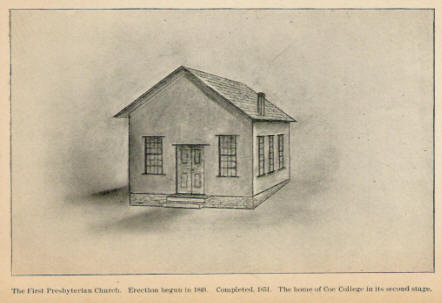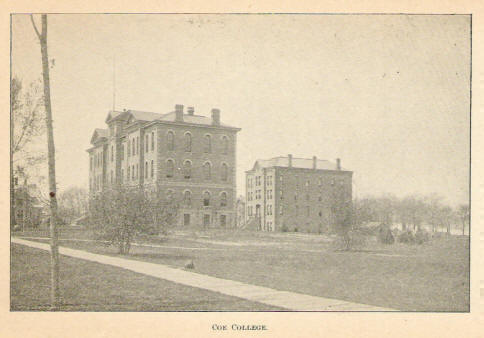|
In the second
stage of its existence the school found shelter in the “Little
Muddy Church” where its sessions were held.

Out of this
humble beginning, Coe College, an institution which at
present is the pride of our city, has grown. Mr. Jones procured
from Mr. Daniel B. Coe, in New York, money sufficient to
purchase the eighty acres of land, a part of which now
constitutes the college campus. A part of the money was invested
in the lots which are now occupied by the First Presbyterian
church and chapel, and also those occupied by St. Paul’s M. E.
church and parsonage.
After passing
through various changes of form and name, and having a history
in which there has been some sunshine, and a great deal of
shadow, Coe College was incorporated, under the laws of the
State of Iowa, in 1881, and the Rev. Stephen Phelps, D. D., was
made its first President, in which relation he continued until
1887.
Although the
foundation upon which Coe College has been built up was not laid
till 1851, which is at a period later than that of which I have
been writing, yet it will be seen that the pioneers of the
forties were the principal workers who inaugurated the great
enterprise.
Rev. Williston
Jones, Judge Greene, Dr. Ely, William Greene, Dr. Carpenter,
Judge Cook and John L. Shearer, whose names are indissolubly
connected with the enterprise from its earliest conception, were
all numbered among the early settlers of that period which this
record is designed to cover.
It is with
pleasure, therefore, that the accompanying illustration, which
shows Coe College as it now stands, is here presented.

Under the able
administration of Rev. James Marshall, D. D., with a faculty
well qualified to fill the various professorships; with
apparatus and appliances for study unexcelled by many older
institutions of learning; with its fine list of students, and
with its admirable constituency, composed of some of our best
citizens here and in other parts of the state, Coe College has a
bright outlook and a promising future, such as to make her
friends rejoice.
To Rev.
Williston Jones belongs the honor of founding this noble
institution.
Mr. Jones
afterwards lived for several years at Iowa Falls, continuing his
labors with a zeal and energy, such as is seldom witnessed in
this world.
His death
occurred at Rolla, Missouri, November 20, 1865, where he had
resided but a short time.
His accomplished
and devoted wife, who has also been untiring in various branches
of Christian work, still survives, and is a resident of
Wellesley, Massachusetts.
On the ground
where once stood the Little Muddy church now stands the
magnificent United States Post office and Court House, which was
erected under the superintendency of Mr. H. S. Josselyn, at a
cost, including grounds, of one hundred and twenty thousand
dollars. It is a solid structure, built of brick and stone, and
in its architectural style and proportions, it is one of the
most splendid ornaments of the city.
But with all
its imposing grandeur and stateliness, it has never cost the
self-denial, the days of toil and anxiety that were endured by
the builders of that first little church, whose walls were
reared in those early days when the men were so few and money so
scarce and the materials so hard to procure. |